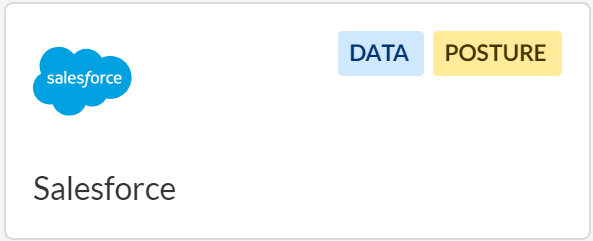SaaS Security
Begin Scanning a Salesforce App
Table of Contents
Expand All
|
Collapse All
SaaS Security Docs
Begin Scanning a Salesforce App
Learn how to add a Salesforce app so that Data Security can protect your assets against data exfiltration and malware
propagation.
| Where Can I Use This? | What Do I Need? |
|---|---|
|
Or any of the following licenses that include the Data Security license:
|
To begin scanning a Salesforce app:
- Ensure that the Salesforce administrator account you plan to connect to Data Security has sufficient administrator privileges.To configure the required permissions within Salesforce:
- Under Setup, select Manage UsersUsers.Select the administrative user account and then click System Permissions.Under System, enable the following permissions:
- API Enabled
- Manage Chatter Messages (required only if you use Chatter)
- Modify All Data
- View All Data
- Query All Files
Under Users, enable the following permissions:- View All Users
- Manage Users (required only if you have not enabled User Sharing)
To add the Salesforce app to Data Security, go to Data SecurityApplicationsAdd ApplicationSalesforce.![]()
- (For SaaS Security Console users only) Choose the type of Salesforce application:
- Connect to Salesforce Account—Adds your Salesforce production account to Data Security.
- Connect to Salesforce Sandbox—Adds your Salesforce sandbox account to Data Security. Sandboxes are special Salesforce accounts that are maintained separately from your product account and are useful for development, testing, and training.
Log in to Salesforce.(Optional) Give a descriptive name to the Salesforce instance.- Click Settings and select the Salesforce n listed.Enter a descriptive Name to differentiate this instance of Salesforce from other instances and click Done.(Optional) Adjust the maximum number of API calls allowed from Data Security to Salesforce.By default, Data Security can send a maximum of 10,000 API calls to Salesforce.Define global scan settings.Add policy rules.When you add a cloud app, Data Security automatically scans the app against the default data patterns and displays any match occurrences. As a best practice, consider the business use of your app to determine whether you want to Add a New Data Asset Policy to look for incidents unique to Salesforce.Configure or edit a data pattern.You can Configure Data Patterns to identify specific strings of text, characters, words, or patterns to make it possible to find all instances of text that match a data pattern you specify.To start scanning Salesforce for any possible policy violations or data exposure, go to Data SecurityApplicationsSalesforceEnable Scanning.Data Security scans all assets in the associated Salesforce app and identifies incidents. Depending on the number of Salesforce users and assets, it may take some time for Data Security to complete the process. However, you can Monitor Scan Results on the Dashboard and begin to Assess Incidents. Monitoring the progress of the scan during the discovery phase allows you to Fine-Tune Policy to modify the match criteria and ensure better results.

